B
| Brandsbutt stone |
|---|

A class I Pictish symbol stone that may re-use a megalith from the stone circle that once stood here. 3 feet 6 inches high by 4 feet 2 inches wide by about 3 feet thick. It is re-assembled from fragments found in a dyke and some missing parts are substituted with cement. The south-east face bears the crescent and V rod and serpent and z rod symbols to the left of the symbols is an ogam inscription which reads IRATADDOARENS some part of which may be a version of the name Ethernan (as in St.Ethernan). |
| Broomend of Crichie |

A class I Pictish Symbol stone located in the remains of a class II henge monument (a henge is defined by having a bank and ditch class II henges are those with two opposed entrances). The symbol stone was originally located on a bank 50 yards to the north-east and was moved when this bank was utilised as ballast during the construction of the adjacent railway line. It was probably a Pictish reuse of one of the megaliths that formed the avenue and the other stone circle mentioned below. It bears a 'Pictish Beast' symbol over a crescent and V rod. More Information |
C
| Corsearder, Corsedarder or Corsedardar Stone |
|---|

A squarish block of reddish granite, about 4'7" in maximum height and 7' in girth, which was dug up many years before 1842 and was erected on top of the hill of Corsedardar, in the belief that it had marked the grave of some eminent person. The stone has been split, and now has the two portions set into a bed of concrete and pieced together by strong iron bands. Tradition says that it marks the spot where Dardanus, a Pictish king, was killed. A stone, 1.5m high, 0.8m wide, and 0.2m thick, generally as described, and possibly a cist slab. Visited by OS (R L) 12 June 1972. from RCAHMS |
E
| Early Crosses, Banchory |
|---|

A relic of St Ternan's Monastery still remaining at Banchory is a slab with two incised Celtic crosses, built into the Tilquilly vault in the chuchyard. Discovered by J W Robertson, Aberdeen. |
F
| Features at Dunnottar Castle |
|---|

The castle; probably occupies the site of a prehistoric fort. St Ninian established a church here about the beginning of the 5thC. It may also be the -Dunfoithir- besieged in 681. In the reign of William the Lion (1165-1214) -Dunnottar- was the place where warrants were returnable for the Mearns, and -le castiel de Dunostre- is mentioned at the beginning of the 13thC. Another castle was erected at the end of the 14thC. In its final form the castle was forfeited in 1716 and the roofs and floors removed and sold. In 1925 the systematic repair and excavation of the ruins was begun.In its present form the extensive remains date from various periods. The oldest portion is the early 15thC keep with a range of buildings extending to the E containing stables & storehouses. The gatehouse is approached by a steep path and defended by three tiers of splayed gun-loops. The arched entrance is the only opening on a solid wall of masonry set into a cleft in the rock; a very impressive and dominating entrance. The buildings to the NW grouped round a courtyard date from the late 16th or early 17thC, including a chapel. A huge water system lies within the courtyard. There is also a bowling green to the W of this later range. The Scottish Crown jewels (The Honours of Scotland) were hidden here in 1651 as it was considered one of the strongest places in the kingdom. In 1685 167 Covenanters were packed into a small vault, (the Whigs Vault) where 9 died due to the terrible conditions. Privately owned (Dunecht Estates) and open to the public. An oval motte was noted in 1970. More Information |
| Fetterangus Pictish Symbol Stone |
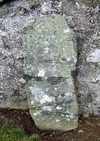
A class 1 symbol stone lies at the entrance to the graveyard of Fetterangus Church. It is of whinstone, 1.1m x 0.78m, and is much weathered, the carving is almost invisible to the naked eye, Near the top was a triple disc and bar or "cauldron" symbol below which was a rimmed "mirror case" its base containing opposed arcs with a palimpsest of another circular symbol overlapping it, at the bottom was a figure composed of a horizontal line and 2 curved lines one with a spiral end. Note some published descriptions are given with the stone the opposite way up to the above. Fairly clear photographs taken by Professor James Ritchie circa 1904 can be seen on the RCAHMS website (Archive Numbers: SC 676586, SC 676550, and SC1081353 the first stone shown on the linked page SC 676546 is another class 1 stone I cannot identify) follow the external link below . More Information |
| Formaston Stone |
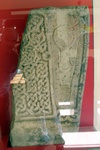
A fragment of a class II Pictish Symbol Stone. It is carved on one face only with a small rimmed ‘mirror’ symbol and part of an interlace filled cross-shaft. The mirror has a long handle with a boss at the end. There are two vertical Ogam inscriptions, Ogam was probably introduced to the Picts from the Gaelic speaking Scots in the 8th Century, they read MAQQoiTALLUORRH and NAHHTVROBBACCAANNEVV. MAQQ may mean son of or descendant of. The oi following is expressed as a small circle. |
| Fyvie 1 |
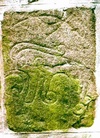
Fyvie Parish Church is at the east end of Fyvie, on the south side of the B9005. Set in the east wall of the church are three worn Pictish class I symbol stones, all have been trimmed. |
| Fyvie 2 |
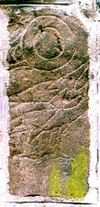
Fyvie Parish Church is at the east end of Fyvie, on the south side of the B9005. Set in the east wall of the church are three worn Pictish class I symbol stones, all have been trimmed. |
I
| Inverurie 3 and 2 |
|---|

Inverurie 3 is the lower part of a Class I Pictish slab showing most of a double disc and z rod symbol and what may be the lower part of a disc symbol. Inverurie 2 is a very small fragment showing part of an ornately patterned mirror symbol. As well as Inverurie 4 (the famous Inverurie Horse), Inverurie 1 is located in the same place but is too worn to photograph well. More Information |
| Inverurie 4 |

A class I Pictish stone showing a horse the only occurrence of the horse in symbol form although hunting scenes with horses and riders are a frequent element of class II stones. As with all Pictish Symbol stones dating is somewhat contentious. As the stone is somewhat eroded a superimposed drawing is included to show detail. As well as Inverurie 3 and 2, Inverurie 1 is located in the same place but is too worn to photograph well. More Information |
K
| Kinord Stone |
|---|
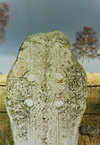
A large class III Pictish cross slab in pink granite 6 feet 3 inches high by 3 feet 1 inch wide carved on one face. More Information |
| Kintore 1 |
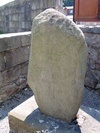
class I Pictish stone discovered underground in the churchyard (re used as a gravecover?). Now stands near the churchyard wall in a recess to the right of the entrance. |
| Kintore 4 |

A class I Pictish stone found in a garden in Kintore in 1974 at NJ790162 now in Inverurie museum it has a well executed Pictish beast and a rectangular symbol of which this is the only known occurence, also a plain mirror but no comb. More Information |
M
| Maiden Stone, Drumdurno |
|---|
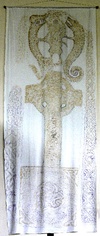
Class II relief carved pink granite Pictish Symbol Stone, 3 metres 20 cm x 86 cm x 25cm. The symbols being the notched rectangle and Z rod and the Pictish Beast (A.K.A. elephant, dolphin) with a mirror and comb qualifier. East face has 4 panels. The top one has various beasts and a Pict headed centaur, The second panel the notched rectangle and Z rod, the third the Pictish Beast and the bottom panel the mirror and comb. |
| Migvie Class II Pictish Symbol Stone |
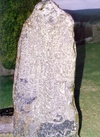
Class II Pictish Symbol Stone 180 x 70 x 38 cm. A low relief cross composed of coarse double interlace is carved in low relief on the east face from the angles of the arms and the top corners of the cross there are short projections ending in rings, which may represent hanging rings. In each quadrant is a symbol in very low relief. Upper left a small clumsy double disc and z rod, upper right even smaller horseshoe and v rod. To the lower right the remains of a mounted figure and two lower left a pair of shears the only known example of this symbol. On the reverse of the stone is a long haired horseman in low relief. This stone is striking by comparison to most Class II Pictish stones in the amateurishness of its execution. I can imagine a customer who could not come at the price demanded by a professional sculptor and instead commissioned a local handyman who was a bit out of his depth. The rider on the reverse seems much more accomplished perhaps a good stencil? More Information |
P
| Percylieu Stone |
|---|
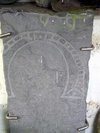
Pictish class 1 stone with part of a Salmon and Horseshoe symbols. More Information |
| Picardy Stone, Myreton |

Class 1 Grey Whinstone Pictish Symbol Stone, 201cm x 102cm x 60cm. Three carved symbols on the south face, from top: Double Disc and Z-rod; Snake and Z-rod and a mirror. The stone stands on its original site, a low cairn, which is in a fenced enclosure, in front of the stone was a grave, this association makes this stone important to those who support the theory of symbol stones as memorials to dead individuals. More Information |
R
| Rhynie 5 |
|---|
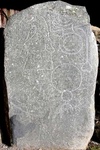
A class I Pictish stone made of gabbro showing a 'double disc and z rod symbol' with a symbol variously interpreted as a dog's head or as a mask made from the skin of a hind, accompanied by the mirror and comb regarded as a qualifying symbol. As with all Pictish Symbol stones dating is somewhat contentious. There are cup marks on the back of the stone suggesting Pictish re-use of a stone made significant in the Neolithic. Two other fragmentery stones, Rhynie 6 and 8, are at the same location. In all 8 symbol stones are known from Rhynie (suggesting a site of major importance) including the 'Rhynie Man' carving 7. Rhynie 4 has been broken up and lost, Rhynie 1 'The Craw Stane' is in situ 2 and 3 stand in the village sqare but their carving is now illegible to the human eye. More Information |
| Rhynie 6 |

A fragment of a class I Pictish stone made of pink granite the very bottom of a vertical double disc and Z rod can just be seen above a plain crescent and V rod and a mirror. Two other stones, Rhynie 5 and the fragmentery 8, are at the same location. In all 8 symbol stones are known from Rhynie (suggesting a site of major importance) including the 'Rhynie Man' carving 7. Rhynie 4 has been broken up and lost, Rhynie 1 'The Craw Stane' is in situ 2 and 3 stand in the village sqare but their carving is now illegible to the human eye. More Information |
| Rothiebrisbane Symbol Stone |
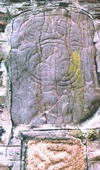
Fyvie Parish Church is at the east end of Fyvie, on the south side of the B9005. Set in the east wall of the church are three worn Pictish class I symbol stones, all have been trimmed. |
S
| Standing Stones of Strathbogie |
|---|

Two small standing stones that may once have formed part of a stone circle. One of them has been used as a Pictish symbol stone marked with the 'horseshoe' and 'double-disc' symbols, these are no longer legible. More Information |
T
| The Craw Stane (Rhynie 1) |
|---|

Class I Pictish symbol stone. The stone faces south it is a large stone 180cm by 102cm by 43cm. It has near the top a large Salmon symbol above a Pictish beast. It stands at one side of the inner entrance to an almost imperceptable (but clear in ariel photgraphs of crop marks) multi-vallate circular enclosure crowning the end of a low spur. It could possibly have been a structural feature re-used in situ as a symbol stone. More Information |
| The Raven Stone |

A class one Pictish stone showing the Sea Eagle and notched rectangle with z rod symbols the black infill is recent. As with all Pictish Symbol stones dating is somewhat contentious. The name 'The Raven Stone' probably originated as the result of a mistaken association of the stone and a nearby burial mound (in the manse garden) by the antiquarians of the past with Danish invaders. More Information |
| The Wolf Stone |

Pictish Class 1 stone bearing the rectangle symbol sometimes described as a book case and a wolf, plus the mirror and comb symbol. More Information |
This content was submitted by external contributors and does not necessarily reflect the views of the University of Aberdeen.
